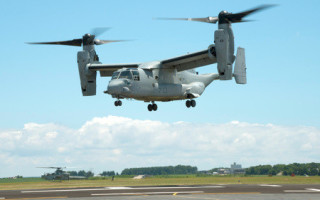3D-printed, safety critical parts fly on V-22 Osprey
NewsAugust 01, 2016

PATUXENT RIVER, Maryland. Naval Air Systems Command (NAVAIR) officials announced the completion of a flight demonstrating flight critical aircraft component built using additive manufacturing (AM) techniques also known as 3D printing.
Pilots on a MV-22B Osprey performed a test flight of the aircraft outfitted with a titanium, 3-D printed link and fitting assembly for the engine nacelle -- one of four that secure a V-22's engine nacelle to the primary wing structure. The 3-D printed equipment will remain on the aircraft for continued evaluation. According to the Navy flight was operated using the standard V-22 flight performance envelope.
"The flight went great. I never would have known that we had anything different onboard," says MV-22 Project Officer Maj. Travis Stephenson who piloted the flight.
Additive manufacturing uses digital 3D design data to build components in layers of metal, plastic, and other materials, according to a NAVAIR release. The metal link and fitting assembly for this particular test event were printed at Naval Air Warfare Center Aircraft Division in Lakehurst, New Jersey.
Naval aviation has employed additive manufacturing as a prototyping tool since the early 1990s and in recent years began printing non-flight critical parts and tools. Today's demonstration is the first time a U.S. Navy aircraft flew with an Additive Manufacturing part deemed essential to maintaining safe flight. Navy officials say they would like to see a future where all parts can be made on-demand globally by fleet maintainers and operators, and industry partners - stocking digital data instead of ordering, stocking, and shipping parts.
Prior to this flight, multiple V-22 components built by Lakehurst and Penn State Applied Research Laboratory personnel were tested at Patuxent River to validate performance.
"The flight today is a great first step toward using [additive manufacturing] wherever and whenever we need to. It will revolutionize how we repair our aircraft and develop and field new capabilities - [additive manufacturing is a game changer," says Liz McMichael, [Additive Manufacturing] Integrated Product Team lead. "In the last 18 months, we've started to crack the code on using [Additive Manufacturing] safely. We'll be working with V-22 to go from this first flight demonstration to a formal configuration change to use these parts on any V-22 aircraft."
[caption id="" align="alignnone" width="450" caption="Aviation Mechanic Cody Schwarz works on installing a 3-D printed titanium link and fitting on an MV-22B Osprey engine nacelle at Patuxent River Naval Air Station, Maryland. He can be seen in this image holding the link prior to affixing it to the aircraft. (U.S. Navy photo/Released)"] [/caption]
[/caption]
Including the V-22 link and fitting assembly, McMichael and her team say they have identified six additional safety-critical parts they plan to build and test over the next year for three U.S. Marine Corps rotorcraft platforms: the V-22, H-1 Huey helicopters, and U.S. Marine Corps' CH-53K Marine helicopter. Three of the parts will be made out of titanium, while the other three will be stainless steel.
NAVAIR officials caution that there is still much work to do before deployed aircraft are flying in theater with 3D printed, safety-critical parts.
"Although the flight today is a great step forward, we are not trying to 'lead' industry in our [Additive Manufacturing] efforts, but it is absolutely critical that we understand what it takes to successfully manufacture and qualify [Additive Manufacturing] parts for flight in naval aircraft, which we expect will largely be manufactured by our industry partners," says Vice Adm. Paul A. Grosklags, NAVAIR commander. "Where I believe we can 'lead' industry is in the development of the [Additive Manufacturing] "digital thread," from initial design tools all the way to the flight line - securely maintained and managed through the life of an aircraft program."







